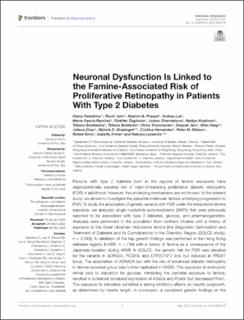Neuronal Dysfunction Is Linked to the Famine-Associated Risk of Proliferative Retinopathy in Patients With Type 2 Diabetes
| dc.contributor.author | Fedotkina, Olena | |
| dc.contributor.author | Jain, Ruchi | |
| dc.contributor.author | Prasad, Rashmi B. | |
| dc.contributor.author | Luk, Andrea | |
| dc.contributor.author | García-Ramírez, Marta | |
| dc.contributor.author | Özgümüs, Türküler | |
| dc.contributor.author | Cherviakova, Liubov | |
| dc.contributor.author | Khalimon, Nadiya | |
| dc.contributor.author | Svietleisha, Tetiana | |
| dc.contributor.author | Buldenko, Tetiana | |
| dc.contributor.author | Kravchenko, Victor | |
| dc.contributor.author | Jain, Deepak | |
| dc.contributor.author | Vaag, Allan | |
| dc.contributor.author | Chan, Juliana | |
| dc.contributor.author | Khalangot, Mykola D. | |
| dc.contributor.author | Hernández, Cristina | |
| dc.contributor.author | Nilsson, Peter M. | |
| dc.contributor.author | Simo, Rafael | |
| dc.contributor.author | Artner, Isabella | |
| dc.contributor.author | Lyssenko, Valeriya | |
| dc.date.accessioned | 2022-12-01T11:43:54Z | |
| dc.date.available | 2022-12-01T11:43:54Z | |
| dc.date.created | 2022-08-30T12:35:51Z | |
| dc.date.issued | 2022-05-05 | |
| dc.identifier.issn | 1662-4548 | |
| dc.identifier.uri | https://hdl.handle.net/11250/3035308 | |
| dc.description.abstract | Persons with type 2 diabetes born in the regions of famine exposures have disproportionally elevated risk of vision-threatening proliferative diabetic retinopathy (PDR) in adulthood. However, the underlying mechanisms are not known. In the present study, we aimed to investigate the plausible molecular factors underlying progression to PDR. To study the association of genetic variants with PDR under the intrauterine famine exposure, we analyzed single nucleotide polymorphisms (SNPs) that were previously reported to be associated with type 2 diabetes, glucose, and pharmacogenetics. Analyses were performed in the population from northern Ukraine with a history of exposure to the Great Ukrainian Holodomor famine [the Diagnostic Optimization and Treatment of Diabetes and its Complications in the Chernihiv Region (DOLCE study), n = 3,583]. A validation of the top genetic findings was performed in the Hong Kong diabetes registry (HKDR, n = 730) with a history of famine as a consequence of the Japanese invasion during WWII. In DOLCE, the genetic risk for PDR was elevated for the variants in ADRA2A, PCSK9, and CYP2C19*2 loci, but reduced at PROX1 locus. The association of ADRA2A loci with the risk of advanced diabetic retinopathy in famine-exposed group was further replicated in HKDR. The exposure of embryonic retinal cells to starvation for glucose, mimicking the perinatal exposure to famine, resulted in sustained increased expression of Adra2a and Pcsk9, but decreased Prox1. The exposure to starvation exhibited a lasting inhibitory effects on neurite outgrowth, as determined by neurite length. In conclusion, a consistent genetic findings on the famine-linked risk of ADRA2A with PDR indicate that the nerves may likely to be responsible for communicating the effects of perinatal exposure to famine on the elevated risk of advanced stages of diabetic retinopathy in adults. These results suggest the possibility of utilizing neuroprotective drugs for the prevention and treatment of PDR. | en_US |
| dc.language.iso | eng | en_US |
| dc.publisher | Frontiers | en_US |
| dc.rights | Navngivelse 4.0 Internasjonal | * |
| dc.rights.uri | http://creativecommons.org/licenses/by/4.0/deed.no | * |
| dc.title | Neuronal Dysfunction Is Linked to the Famine-Associated Risk of Proliferative Retinopathy in Patients With Type 2 Diabetes | en_US |
| dc.type | Journal article | en_US |
| dc.type | Peer reviewed | en_US |
| dc.description.version | publishedVersion | en_US |
| dc.rights.holder | Copyright 2022 the authors | en_US |
| dc.source.articlenumber | 858049 | en_US |
| cristin.ispublished | true | |
| cristin.fulltext | original | |
| cristin.qualitycode | 1 | |
| dc.identifier.doi | 10.3389/fnins.2022.858049 | |
| dc.identifier.cristin | 2047168 | |
| dc.source.journal | Frontiers in Neuroscience | en_US |
| dc.identifier.citation | Frontiers in Neuroscience. 2022, 16, 858049. | en_US |
| dc.source.volume | 16 | en_US |
Files in this item
This item appears in the following Collection(s)
-
Department of Clinical Science [2310]
-
Registrations from Cristin [9688]

